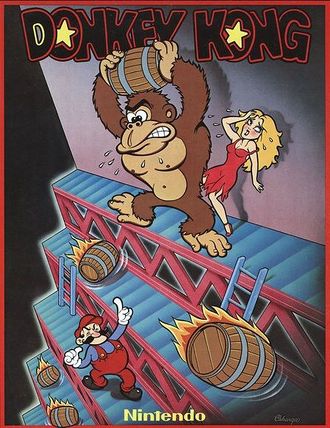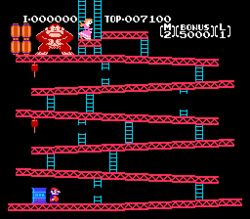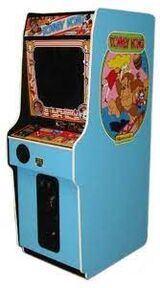Donkey Kong (video game): Difference between revisions
(fix category) |
(iQue -> iQue Player) |
||
| Line 76: | Line 76: | ||
[[Category:video games developed by Nintendo]] | [[Category:video games developed by Nintendo]] | ||
[[Category:video games developed by Nintendo Research & Development 1]] | [[Category:video games developed by Nintendo Research & Development 1]] | ||
[[Category:video games included in Animal Forest for Nintendo 64 and iQue]] | [[Category:video games included in Animal Forest for Nintendo 64 and iQue Player]] | ||
[[Category:video games included in Animal Forest+ for GameCube]] | [[Category:video games included in Animal Forest+ for GameCube]] | ||
[[Category:video games included in Animal Crossing for GameCube]] | [[Category:video games included in Animal Crossing for GameCube]] | ||
Revision as of 23:30, 22 May 2024
This article is about the arcade game. For the Game & Watch game, see Donkey Kong (Game & Watch video game).

| |
| Donkey Kong | |
| Developer | Nintendo R&D1, Ikegami Tsushinki Coleco (Atari 2600, ColecoVision, Intellivision) Nintendo R&D2 (NES) |
|---|---|
| Publisher | Nintendo Hamster (Arcade Archives) |
| Platforms | Arcade, Atari 2600, Atari 7800, Atari 8-bit computers, ColecoVision, GameCube, Intellivision, iQue Player, NES Classic Edition, Nintendo 3DS, Nintendo 64, Nintendo e-Reader, Nintendo Switch, TI-99/4A, VIC-20, Wii, Wii U |
| Released | Arcade JP: July 9, 1981 NA: July 31, 1981 EU: 1981 ColecoVision NA: 1982 Atari 2600, 8-bit, Intelivision, TI-99/4A, VIC-20 NA: 1983 Nintendo Entertainment System/Famicom JP: July 15, 1983 NA: June 1, 1986 EU: October 15, 1986 Atari 7800 NA: 1986 Nintendo 64 (Animal Forest) JP: April 14, 2001 GameCube JP (Animal Forest+): December 14, 2001 NA (Animal Crossing): September 15, 2002 JP (Animal Forest e+): June 27, 2003 EU (Animal Crossing): September 24, 2004 Game Boy Advance WW (Nintendo e-Reader): 2002 JP (Classic NES Series): February 14, 2004 NA (Classic NES Series): June 7, 2004 EU/Oceania (Classic NES Series): July 9, 2004 iQue Player (Animal Forest) China: June 1, 2006 Wii NA: November 19, 2006 JP (Virtual Console, NES): December 2, 2006 AU (Virtual Console, NES): December 7, 2006 EU (Virtual Console, NES): December 8, 2006 EU (Original Edition, NES): 2010 Nintendo 3DS EU (Original Edition, NES): October 29, 2010 JP (Original Edition, NES): July 28, 2012 NA (Original Edition, NES): October 1, 2012 JP (Virtual Console, NES): October 17, 2012 Wii U (Virtual Console, NES) WW: July 15, 2013 NA: August 15, 2013 JP: November 21, 2013 NES Classic Edition/Famicom Mini AU/JP: November 10, 2016 EU/NA: November 11, 2016 Nintendo Switch NA (Arcade Archives, arcade): June 14, 2018 AU/EU/JP (Arcade Archives, arcade): June 15, 2018 WW (Online, NES): September 18, 2018 |
| Added to Museum |
GC (Animal Crossing): January 20, 2003 NES CE: June 22, 2017 Famicom Mini: August 10, 2017 GBA (e-Reader): January 20, 2018 Switch (Arcade Archives): August 16, 2018 TI-99/4A: February 3, 2020 |

|
Donkey Kong was first released for the arcade. It was developed by Nintendo Research & Development 1, with code development subcontracted to Ikegami Tsushinki, and was published by Nintendo in 1981. It was the first game in the Donkey Kong series. It was also the first game to feature Nintendo's mascot Mario. As such, it was brought to most of Nintendo's subsequent systems, either as ports or through emulation.
Story
An Italian-American carpenter named Mario had a pet gorilla, Donkey Kong, that captured Mario's girlfriend Pauline.
Mario then chased down Donkey Kong to several construction sites.
Each time he rescued Pauline, Donkey Kong took her up to a higher level, and Mario followed.
Eventually, Mario manages to make the beams collapse with Donkey Kong on top of them.
Unfortunately, Donkey Kong just captured Pauline again, and Mario's chase continued.
Development
Radar Scope was a hit in Japan when it was released in 1980, but when it released in North America, it sold poorly. Nintendo of America asked for a game that could be installed in the unsold Radar Scope cabinets.
Nintendo asked its designers for ideas, and Shigeru Miyamoto's idea was chosen.
Originally Miyamoto wanted to use Popeye characters, but Nintendo could not secure the rights.
The game was designed with original characters instead, and code development was subcontracted to Ikegami Tsushinki.
The resulting game was Donkey Kong, which was a worldwide success.
Versions of the game
As the first game to feature Nintendo's mascot Mario, it has been released on many different systems, both through traditional game ports and through emulation. It was first released to arcades in 1981.
Coleco secured the rights to release the game to home video game consoles. Coleco published it on ColecoVision in 1982, Atari 2600 and Intellivision in 1983, and Atari 7800 in 1986.
Atari secured the rights to release the game to computers. Atari published it on Atari 8-bit computers, TI-99/4A, and VIC-20 in 1983.
Nintendo published the game themselves after this. Nintendo published it on Famicom in 1983 and NES in 1986. It was included as an unlockable game in Animal Forest on Nintendo 64 in Japan in 2001 and on GameCube in 2002. It was also released on the localized version, Animal Crossing, on GameCube in 2002 in North America and in Europe in 2004. The Nintendo subsidiary iQue released Animal Crossing for the iQue Player in 2006. This version included Donkey Kong as well.
It was released on Virtual Console for Wii in 2006, for the Nintendo 3DS in 2012 in Japan and Europe and North America in 2013, and for Wii U worldwide in 2013.
Donkey Kong Original Edition, a version for the NES with the factory level, was released for Wii in Europe in 2010, and on Nintendo 3DS in North America and Europe in 2010.
The standard NES version was also released as a five-card release for the Nintendo e-Reader in 2012.
It was released on the NES Classic Edition and Famicom Mini in 2016.
It was released for Nintendo Switch via Arcade Archives and for the Nintendo Entertainment System – Nintendo Switch Online emulation service in 2018.

